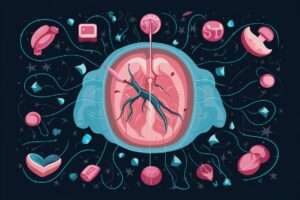Sexually Transmitted Diseases (STDs): A Comprehensive Guide to Understanding, Prevention and Treatment
Sexually transmitted diseases (STDs), also known as sexually transmitted infections (STIs), are a significant public health concern affecting millions of people worldwide.
In this comprehensive guide, we’ll explore everything you need to know about STDs, from common types and symptoms to prevention strategies and treatment options.
Whether you’re sexually active or simply looking to educate yourself, this article will provide valuable insights to help you protect your sexual health.

Table of Contents
ToggleThe Global Impact of STDs
Before we dive into the details, let’s consider the scale of the STD problem. According to the World Health Organization (WHO), more than 1 million STIs are acquired every day worldwide.
In the United States alone, the Centers for Disease Control and Prevention (CDC) estimates that there are about 20 million new STD cases each year. These staggering numbers highlight the importance of education, prevention, and regular testing.
Common Types of STDs
Let’s explore some of the most prevalent STDs, their causes, symptoms, and potential long-term effects:
1. Chlamydia
Cause: Bacteria (Chlamydia trachomatis)
Symptoms: Often asymptomatic; may include genital discharge, burning sensation during urination
Long-term effects: Can lead to pelvic inflammatory disease (PID) and infertility if left untreated.

2. Gonorrhea
Cause: Bacteria (Neisseria gonorrhoeae)
Symptoms: Genital discharge, painful urination, rectal discomfort
Long-term effects: Can cause PID, infertility, and increase the risk of HIV transmission
3. Human Papillomavirus (HPV)
Cause: Virus (Human Papillomavirus)
Symptoms: Often asymptomatic; may cause genital warts
Long-term effects: Some strains can lead to cervical, anal, or throat cancer
4. Genital Herpes
Cause: Virus (Herpes Simplex Virus type 1 or 2)
Symptoms: Painful blisters or sores on genitals, rectum, or mouth
Long-term effects: Recurrent outbreaks throughout life; increased risk of HIV transmission
5. Syphilis
Cause: Bacteria (Treponema pallidum)
Symptoms: Painless sores, rash, flu-like symptoms
Long-term effects: Can damage multiple organ systems if left untreated
6. HIV/AIDS
Cause: Virus (Human Immunodeficiency Virus)
Symptoms: Initially flu-like symptoms; later, opportunistic infections due to weakened immune system
Long-term effects: Without treatment, can progress to AIDS and be life-threatening
7. Trichomoniasis
Cause: Parasite (Trichomonas vaginalis)
Symptoms: Genital itching, burning, and discharge
Long-term effects: Increased risk of HIV transmission; potential complications during pregnancy
8. Hepatitis B
Cause: Virus (Hepatitis B Virus)
Symptoms: Fatigue, abdominal pain, jaundice
Long-term effects: Can lead to chronic liver disease and liver cancer

Transmission of STDs
Understanding how STDs spread is crucial for prevention. STDs can be transmitted through:
1. Vaginal, anal, or oral sex
2. Skin-to-skin genital contact
3. Sharing sex toys
4. From mother to child during pregnancy or childbirth
5. Blood transfusions (rare in countries with robust screening processes)
It’s important to note that many STDs can be transmitted even when there are no visible symptoms.
Prevention Strategies
Preventing STDs is key to maintaining sexual health. Here are some effective strategies:
1. Practice Safe Sex
– Use condoms consistently and correctly for vaginal, anal, and oral sex
– Use dental dams for oral-vaginal or oral-anal contact

2. Get Vaccinated
– HPV vaccine
– Hepatitis B vaccine
3. Regular Testing
– Get tested regularly, especially if you have multiple partners or engage in high-risk behaviors
4. Open Communication
– Discuss sexual health and STD status with partners
– Encourage partners to get tested
5. Abstinence or Mutual Monogamy
– Abstaining from sexual activity or maintaining a mutually monogamous relationship with an uninfected partner can significantly reduce STD risk
6. Limit Sexual Partners
– Reducing the number of sexual partners can lower your risk of exposure to STDs
7. Avoid Alcohol and Drug Use in Sexual Situations
– Substance use can impair judgment and lead to risky sexual behaviors
The Importance of Regular Testing
Regular STD testing is crucial for early detection and treatment. The CDC provides specific testing recommendations based on age, sexual activity, and risk factors. You can find detailed guidelines on their STD screening recommendations page.
Common testing methods include:
1. Urine tests
2. Blood tests
3. Swabs of affected areas
4. Physical examinations
Remember, many STDs can be asymptomatic, so regular testing is essential even if you don’t have any noticeable symptoms.
Treatment Options
Treatment for STDs varies depending on the specific infection:
1. Bacterial STDs (e.g., chlamydia, gonorrhea, syphilis)
– Usually treated with antibiotics
2. Viral STDs (e.g., herpes, HIV, hepatitis B)
– Managed with antiviral medications; some, like HIV, require lifelong treatment
3. Parasitic STDs (e.g., trichomoniasis)
– Treated with antiparasitic medications
It’s crucial to complete the entire course of prescribed treatment, even if symptoms improve. Additionally, inform recent sexual partners so they can also seek testing and treatment if necessary.
Living with STDs
For those diagnosed with chronic STDs like herpes or HIV, living a healthy life is still possible:
1. Adhere to treatment plans
2. Practice safe sex to prevent transmission to partners
3. Seek support from healthcare providers, counselors, or support groups
4. Maintain overall health through diet, exercise, and stress management
The American Sexual Health Association offers valuable resources for people living with STDs.
The Psychological Impact of STDs
Being diagnosed with an STD can have significant emotional and psychological effects. It’s common to experience feelings of shame, anxiety, or depression. Remember that STDs are common health issues, not moral judgments. Seeking support from mental health professionals or support groups can be beneficial in coping with these feelings.
Breaking the Stigma
Stigma surrounding STDs can prevent people from seeking testing and treatment. Education and open dialogue are key to breaking this stigma. By talking openly about sexual health and STDs, we can create a more supportive environment for those affected and encourage proactive health practices.
The Future of STD Prevention and Treatment
Ongoing research continues to improve our understanding and management of STDs. Some promising areas include:
1. New vaccine development (e.g., for herpes and HIV)
2. Improved diagnostic tests for faster, more accurate results
3. Novel treatment approaches, including gene therapy for viral STDs
Stay informed about these developments by following reputable health organizations like the World Health Organization (WHO) and the National Institutes of Health (NIH).
Conclusion
Sexually transmitted diseases are a significant health concern, but with proper education, prevention strategies, and medical care, their impact can be greatly reduced. Remember, taking care of your sexual health is an important part of your overall well-being.
Regular testing, open communication with partners, and practicing safe sex are key steps in preventing and managing STDs.
If you have concerns about your sexual health, don’t hesitate to speak with a healthcare provider. Your health and peace of mind are worth it. Stay informed, stay safe, and take charge of your sexual health.
Reference to External Sources Used:
1. World Health Organization (WHO) – Sexually Transmitted Infections:
2. Centers for Disease Control and Prevention (CDC) – STD Screening Recommendations:
3. American Sexual Health Association – Living with an STD:
4. National Institutes of Health (NIH) – Sexually Transmitted Diseases:
5. Planned Parenthood – STD Testing and Treatment:


